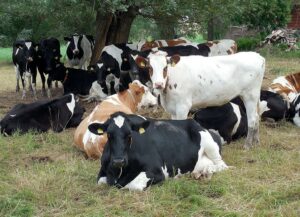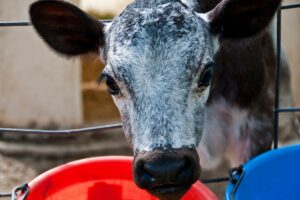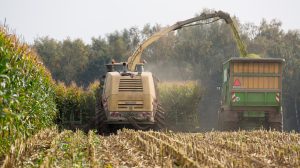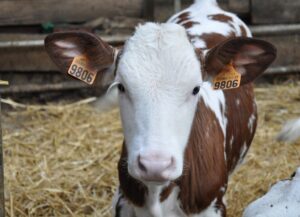Alvaro Garcia
The demand for organic dairy products has been increasing recently. This production system is not devoid of complications, particularly when it comes to animal welfare. The need to produce without synthetic chemicals is oftentimes a challenge when treating ailments. With regards to profitability, organic dairy production is not devoid of similar challenges compared to non-organic production systems. One important component then is to make sure animals can perform with minimal need for medical intervention, while maintaining optimum standards of well-being.
An important question to ask then is if there are differences in breed performance under organic production systems. Previous studies in Northern Spain that compared the nutritional and health status of dairy cows in organic vs. conventional systems have shown that organic farmers are unsatisfied with the performance of Holstein and seek alternatives. These could be either selecting animals within Holstein Friesians with functional traits better adapted to organic farming, using crossbreds or even more adaptable pure breeds.
A recent study evaluated the performance of different breeds and crossbreds in organic dairy farms in Northern Spain. The parameters compared were culling reason, longevity, days in milk until culling, milk production performance, udder health, calving type, calving ease and reproduction performance. Data were obtained from six organic dairies two of which used only Holstein Friesians (H), one H and crossbreds (C; all with H genetics), with the last three using H, Brown Swiss (BS) and C. Data on several lactations and parity of the same cows were grouped by lactation (group 1: 1st lactation; group 2: 2nd and 3rd lactation; group 3: 4th lactation on) or parity (group 1: birth to 1st parity; group 2: 1st to 3rd parity; group 3: 3rd parity on).
Culling reasons, longevity and days in milk until culling
Similar results were found overall for C and BS, with mastitis as the main culling reason (37.8% and 33.3%, respectively) followed by infertility and others (infertility, 22.6% and 16.7%; others, 22.6% and 16.7%, resp.). The main cause of culling for H was others (25.8%), mastitis (22.5%) and death/urgent slaughter (22.4%), with infertility only 13.6%. Death/urgent slaughter culls were H 22.4%, C 12.9%; BS cows 12.5%. The lowest percentage of cows culled for lameness were C with 2.5%, followed by H 9.7% and BS 12.5%. The percentage of culls because of productivity was BS 8.3%, H 4.7%, and C 1.6%; H cows lived 8.46% longer than C and 7.70% longer than BS.
Milk production and udder health
There was higher milk production for H, then C and then BS. Milk fat yield was higher in C with intermediate or higher protein yield. Production of energy-corrected-milk was lower for BS compared to the other two. For SCCs > 200,000 somatic cells/ ml, a breed effect was observed from 2nd lactation on. The highest percentage was for BS, with C having the lowest percentage of samples exceeding 200,000 SCC. The H cows with more lactations increased SCC compared with the other groups. The higher SCC of BS from second lactation on could be related to a lower dilution effect due to low milk yield.
Calving type and ease
All breeds in this study had a standard twinning rate (natural incidence is 1%–5%) with no differences between them. Percentages of twins were 2.3% for H, 3.3% for C, and 0.7% for BS. The highest percentage of cows that delivered alone were C and the lowest levels of difficult delivery, with H performing slightly better than BS.
Reproductive performance
Overall, H heifers were the most precocious (shorter times to first service, conception and calving) and C the least precocious. Furthermore, C required fewer services/conception, with higher percentages of conception at first service. The cows that did worst in this parameter were H. Calving to first service was shorter in H, but the calving to conception and calving intervals were longer than in BS and C because of lower conception rates. Results of this study suggest that H cows suffer less frequently from mastitis and infertility than C or BS cows. However, the SCC value and reproductive performance did not support this observation. The result seemed to indicate H cows will suffer multiple pathologies (e.g. subclinical mastitis and infertility) but maintain acceptable milk yield compared to C and BS. A higher percentage of H cows was culled because of death/ urgent slaughter than C or BS. This could be linked to increased negative energy balance in H. Another interesting finding of the present study was the lower incidence of lameness in C than in BS and H. A larger percentage of H were culled at the end of the lactation due to multiple pathologies (‘others’).
The findings of this study suggest Holstein Friesian cows seem to suit organic production systems of Northern Spain. The reproductive performance of crossbreds and Brown Swiss was better (services/conception), however Holstein Friesian cows produced more and lived longer. The higher milk fat and protein yields in crossbreds may be useful traits for farmers interested in milk solids for yogurt and cheese production. The advantage of Holstein Friesian is that it is the predominant breed worldwide with well-documented genealogy. The authors suggest to prioritize the selection for bulls adapted to pasture-based conditions and to develop a genetic merit index for organic and pasture-based systems to predict and minimize genotype by environment interactions.
Reference
Rodríguez‐Bermúdez, R., Miranda, M., Fouz, R., Orjales, I., Diéguez, F. J., Minervino, A. H. H., López‐Alonso, M. 2020. Breed performance in organic dairy farming in Northern Spain. Reprod Domest Anim.
© 2020 Dairy Knowledge Center, LLC. All Rights Reserved.









